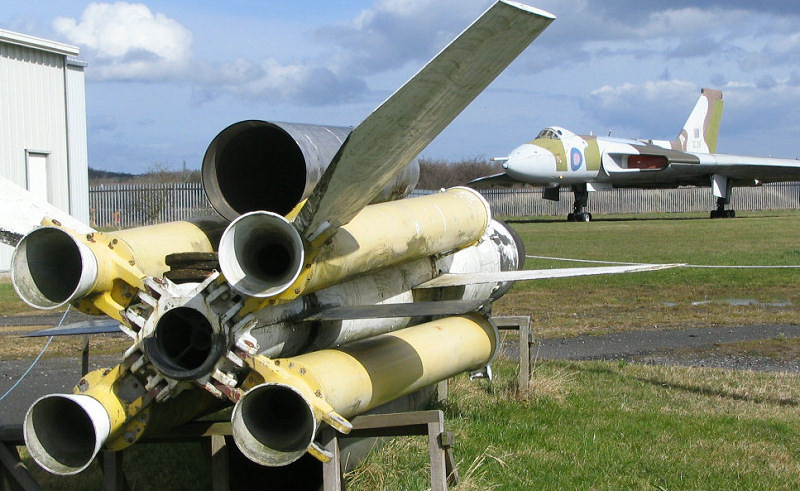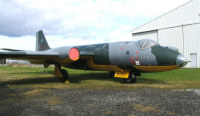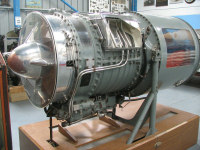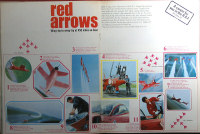

I have visited the site on many occasions and am always impressed with the fact that on each visit there has always been a change in which way the aircraft and other exhibits have been displayed, all with the effort in mind for the visitor to either view or understand what they are looking at to a better advantage, helped also by some small stands next to each aircraft giving a brief but concise history of the aircrafts type and build history. Add all this to free car parking, a low admission fee of £3, kids and OAPs £1.50, friendly helpful staff who will do their best to answer any questions aviation wise and not forgetting to mention there's a good choice of second hand magazines going cheap along with a selection of books and you just cant lose.

Once inside the main viewing area a stillness of atmosphere surrounds the exhibits and a feeling of the past always seems to follow me as I gaze at such things like the remnants of a German bomber's engine, in this case a BMW Bramo radial engine from a Dornier 217 picked up by trawlers from North Shields while fishing in the North Sea, my immediate thoughts pondered the crew's fate, but this line of thought was side tracked soon after spotting two engines sitting side by side that were products from the early days of jet engine development. These were the Welland engine a derivative of the W.1 engine, which powered the first flight of Sir frank Whittles E.28/39 Gloster Whittle jet on May 15th 1941 at Cranwell with a Flt/lt Sayer at the controls of a 17-minute flight. The Welland made by Rolls Royce was the first mass-produced jet engine in the U.K, which was in turn fitted to early production Meteors that saw service in WW2 in 1944 chasing V.1 bombs. Next to this engine was a Bristol Orpheus cutaway display engine marked on the makers plate as Mk1/5 and then on a very small 3cm cover plate was the mark OR 701 so any engine experts out there maybe you know exactly what this mark was by the serial number 120018.What I do know is the engine was primarily designed for use on the Gnat Mk1 in 1953 and the total design concept was down to one Sir Stanley Hooker who had only previously helped on other projects but this was his from start to finish and the 100 series engine a progression from this was to power one of my favourite aircraft the Gnat T.1 trainers first flight on August 31 1959 known then as the Fo144 Gnat trainer.
It seemed ironic that as I gazed on this artefact as if left by a visiting alien spaceship that I felt my age and years and couldn't believe 41 years had passed me by that afternoon in 1965 where I was held spellbound, gripped with scarlet fever as the Red Arrows told me in their flying skill what passion and commitment were about as they weaved around Usworth leaving everyone in their spell with me even at the tender age of thirteen listening to men in white shirts going home talking to wives and family about the Battle of Britain with the mood so high I pedalled home to Gosforth dreaming aircraft .Getting back to reality and the engines, designer Dr Stanley Hooker was once described by Bill Bedford, giving an after dinner talk at the Dorchester in London, that had he been asked to choose between Brunel and Stanley his vote would have to be with Mr Stanley, Bill Bedford took the P.1127,(Harrier) for its first conventional flight on the 13th March 1961 at Bedford, the Bristol aircraft company later merged with B.A.C the British Aircraft Corporation in the early 60s.A final twist in the tale of the Orpheus engine relates back to the mid 60s when Donald Campbell was trying to break the water speed record in Bluebird which just happened also to be powered by an Orpheus engine tragically Mr Campbell was killed in the attempt and his speedboat was recovered only a few years ago from Lake Coniston eventually to be brought to North Shields for restoration. Just before I move onto the next exhibit I want to mention one of the magazines I bought and this was a 1967 issue of the Royal Air Force souvenir book which highlighted a recruiting advert featuring the Red Arrows, something rare in advertising I think on paper and a nice way to round off my daydreaming session of 1965.

|

|
|
Something of complete contrast very close by was an Anderson air raid shelter, the type given by the authorities at the time to each household for protection during bombing raids in WW2. The one featured in the museum was laid out with items from that period down to an old newspaper to try and convey what it must have been like at the time. Also featured in the same room are a nice display of model aircraft most of which were used during the cold war period, and somewhere near this display was an actual demonstration training round tactical freefall bomb called the WE 177 made by Hunting Ltd same manufacturer of the piston and Jet provost family .The weapon was made for use in such aircraft as the cancelled TSR2, Vulcan, Tornado and navy Buccaneer all in the event should there have been a nuclear war against Russia and its Warsaw pact allies, thankfully this never happened though, should it have done then this mere 600lb diminutive looking little fella could have knocked out a city the size of Newcastle. Taking all this info on board can only point us in the direction that in this day and age we must strive to always look for the peaceful resolution to keep the big picture of planet Earth in one piece, people like me love to see aircraft fly as they will always be that fascinating piece of machinery that defies gravity, turns peoples heads at displays but in all honesty never really want to see them used in anger, i'm sure that I don't stand alone on this viewpoint.
From the machinery of war to a beautiful small hand built Flying Flea,(G- ADVU) built by The Vintage and Rotary Wing Collection near Stoke On Trent, the aircraft is a replica build from a one flown by a Mr burns in the 1930s with sponsorship coming from his son, a garage owner near the area. Built over a period of 18 months, taking around 1000 man hours, the Flea was copied from a plan book loaned by RAF Hendon, and power being supplied by a two cylinder air cooled 850cc engine similar to the type used by a DAF, the propeller was also made by the same team and its sheer outlook make it stand out in contrast to the more powerful and larger exhibits. I could go on about the place for ages but will just highlight some of my other favourites that are there and these include a Westland Widgeon G-APTW helicopter in a brilliant old scheme, the fuselage of the Swift WK-198 in which Mike Lithgow broke the world speed record on the 25thSept 1953 flying over the Libyan desert at 737.3 Mph at low level, it was later found that the aircraft was better suited to low level flying and ended its days in service as a photo recce. aircraft.
Another great exhibit is an ex-Argentinean Air force FMA 1A 58A Pucara A522, that two engined prop job most people must have caught a glimpse of from the news flashes as the Falklands war was reported on television, five were brought to England via Southampton on the 6th Sept., 1983 the type being 1 from 35 on strength to Grupo 3 De Ataque was moved around since its arrival and had parts removed to enable other flying types be assessed by the Armament and Aircraft Establishment, it was moved to Yeovilton where it was loaned in 1994 to the museum. You have to take your hats off to the crews that flew them in sorties during the conflict especially against the Harrier force, also the Vulcan that can be seen from the A19 road, a B.2A XL 319 last flew with the same squadron, number 44 based at Waddington, which gained recognition in the same conflict for its high altitude bombing raid on Port Stanley Airport along with two other squadrons from the same base, XL 319 was not involved with the "Black Buck" raids.
Rounding off I have include a photo of Meteor F8 WL 181,(ex-AJRS) - "All-weather Jet Refresher Squadron" which was based at Weston Zoyland - as it used to be in better condition when it was outdoors before vandals forced a move for most aircraft to be covered and in a second building, the cramped conditions of this move as you enter the building are apparent as an ex Saudi lightning greets you full on as you enter. A full list of exhibits can be obtained from this link along with other useful information:- www.neam.org.uk
Article and photos by John Bilcliffe |